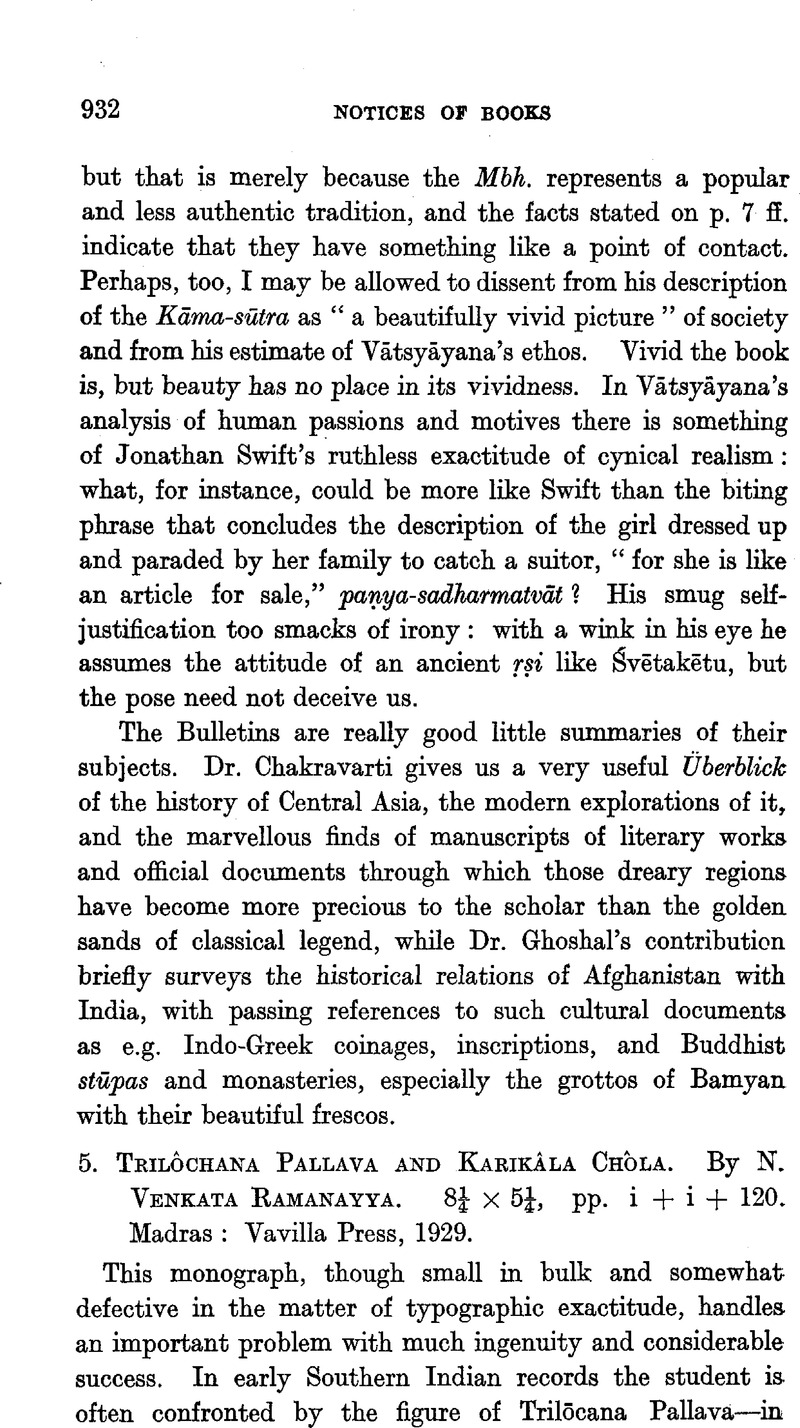No CrossRef data available.
Published online by Cambridge University Press: 15 March 2011

1 The case is not fully developed by Mr. Venkataramanayya, and I take the opportunity to state some of the evidence in more detail. What Dr. Fleet rather sceptically calls the “legendary history” of the early Caḷukyas, (DKD., p. 338 f.Google Scholar) is conveyed in two versions, that of the Eastern and that of the Western Caḷukyas. The former (see El. vi, p. 348, and reff. there) gives the sequence of kings thus: Vijayâditya I, who attacked Trilōcana Pallava and perished; his son Viṣṇuvardhana, who conquered the Kaḍambas, Gaṅgas, etc., and reigned in the Dekhan; his son Vijayâditya II; his son Pulakēsi I. Of the Western records the majority (cf. El. xii, p. 149 f. and reff. there) repeat a common tale; they begin by describing the Calukya race as Viṣṇuvarddhana-Vijayâdityâdi-viśēṣa-nāmnāṃ rāja-ratnānām udbhava-bhūmiḥ, “a mine in which arose gem-like kings bearing the distinctive names Viṣṇuvardhana, Vijayâdditya and the like”, and then they give the well known story that fifty-nine kings of this family ruled in Ayödhyā and sixteen in the Dekhan, after which its fortunes were obscured for a few generations, “checked by evil men,” but were restored by Jayasiṃha, who defeated the Raṭṭas under their king Indra, and was succeeded by his son, Raṇarāga, etc. In the unpublished Handarke inscription to which Dr. Fleet refers (p. 339), the relevant verses are as follows, according to Elliot's transcript: Bhuja-balada Viṣṇuvardhana-Vijayâdityâdi-viruddhan (read virudan) ene ripu-vanitâṃbuja-vanamaṃ koragisidaṃ nija-bāhā-daṃḍa-maṃḍalâgra-prabheyim ‖ Jaya-lakṣmī-kāṃteyaṃ marcisi dhareyan Ayyōdhyâdhipaṃ (read Ayō°)saṃda Sattyâśrayan āḷdaṃ tan-nṛpāḷâgraṇi modal enalēkônaṣaṣṭi-pramaṃ read (kramaṃ) rūḍhiyolird' ā siṃha-pīṭhaṃgaḷoḷ arebar iḷapālar amd' ittam-ittal Jayasiṃhôrvîśan âḷdaṃ baḷikav iḷeyan ā ṣōḍaśôrvîśar āḷdar, the sum of which is that the poet, absurdly making Viṣṇuvardhana and Vijayâditya into one person and putting him at the head of the pedigree, places next fifty-nine kings beginning with Satyâśraya of Ayōdhyā, after whom came “a few” others, then Jayasiṃha, then “the sixteen monarchs”. This account is very confused, but underlying it is the same story as that of the other Western records: the “sixteen monarchs” in either version have a suspicious look (sixteen is a canonical number for kings) and are certainly out of order in this record, while the ascription to Jayasiṃha of a victory over the Raṭṭas in the other documents is no doubt an anachronism, as Dr. Fleet thought. The essential points in the Western tradition are then: the occurrence of the names Viṣṇ. and Vij.; fifty-nine kings of the race in Ayōdhyā with Satyâśraya at the top or near it, and sixteen in the Dekhan; an obscuration in their fortunes lasting a few generations; a restoration by Jayasiṃha; and a continuance of prosperity under his son, Raṇarāga (a biruda, and not a proper name). Apparently tradition placed the names of Viṣṇ. and Vij. at the head of the pedigree, but was doubtful as to their proper place in it. It seems very reasonable to suppose that the Eastern and Western accounts supplement one another, and that the disastrous end of Vijayâditya I and temporary ruin of his realm was a chapter, perhaps the last chapter, in the period of obscuration which the Western records describe as having occurred shortly before the rise of Jayasiṃha. Hence it is permissible as a conjecture to identify Jayasiṃha with Viṣṇuvardhana and Raṇarāga with Vijayâditya II, especially as the Eastern version seems to give a plausible explanation of the rise of Viṣṇ. by successes over the Kaḍambas and Gaṅgas, for whom Western tradition in the tenth century by a natural anachronism substituted the Raṭṭas.